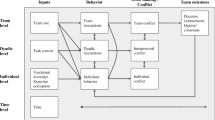Abstract
A Markov model with a coordination parameter isdeveloped to depict coordination and cooperation decisionprocesses in 2 × 2 game relationships. The parameters ofthe model can be used to define and measure various forms ofinfluence. The model is applied to data collected using aprisoner's dilemma payoff structure to represent thesuperior-subordinate relationship. The results demonstrate theusefulness of the model and the measures of influence. Superiorsand subordinates are more likely to coordinate following mutualcooperation, achieving matching behaviors more frequently thanan independent-decisions model would predict. Subordinates showslightly more influence over leaders' behaviors than vice versa.
Similar content being viewed by others
References
Axelrod, R. (1984), The Evolution of Cooperation. New York: Basic Books.
Budescu, D.V. (1984), "Tests of Lagged Dominance in Sequential Dyadic Interaction," Psychological Bulletin, 96, 402–414.
Cable, D.M. and S. Shane (1997), "A Prisoner's Dilemma Approach to Entrepreneur-Venture Capitalist Relationships," Academy of Management Review, 23, 142–176.
Camerer, C. and M. Knez (1997), "Coordination in Organizations," in Z. Shapira (Ed.) Organizational Decision Making, Cambridge.
Dansereau, F.G., G. Graen and W.J. Haga (1975), "A Vertical Dyad Linkage Approach to Leadership within Formal Organizations: A Longitudinal Investigation of the Role Making Process," Organizational Behavior and Human Performance, 13, 46–78.
Dawes, R.M. (1980), "Social Dilemmas," Annual Review of Psychology, 31, 169–193.
Dawes, R.M. and J.M. Orbell (1994), "The Benefit of Optional Play in Anonymous One-Shot Prisoner's Dilemma Games," in K. Arrow, L.R. Mnookin, A. Tversky and R.Wilson (Eds.) Barriers to Conflict Resolution,Norton, 62–85.
Dienesch, R.M. and R.C. Liden (1986), "Leader-Member Exchange Model of Leadership: A Critique and Further Development," Academy of Management Review, 11, 618–634.
Duncan, S. and D.W. Fiske (1979) "Dynamic Patterning in Conversation," American Scientist, 67, 90–98.
Fiedler, F. (1967), A Theory of Leadership Effectiveness.New York: McGraw-Hill.
Glance, N.S. and B.A. Huberman (1993), "The Outbreak of Cooperation," Journal of Mathematical Sociology, 17, 281–302.
Glance, N.S. and B.A. Huberman (1994), "Social Dilemmas and Fluid Organizations," in K.M. Carley and M.J. Prietula (Eds.) Computational Organization Theory, Hillsdale, NJ: Lawrence Erlbaum Associates.
Glance, N.S., T. Hogg and B.A. Huberman (1997), "Training and Turnover in the Evolution of Organizations," Organization Science, 8, 84–96.
Greene, C.N. (1975), "The Reciprocal Nature of Influence between Leader and Subordinate," Journal of Applied Psychology, 60, 187–193.
Greene, C.N. (1979), "Questions of Causation in the Path-Goal Theory of Leadership," Academy of Management Journal, 22, 22–41.
Gottman, J.M. (1980), Marital Interactions: Experimental Investigations. New York: Academic Press.
Hamburger, H. (1969), "Separable Games," Behavioral Science, 14, 121–132.
Hart, P. and C. Saunders (1997), "Power and Trust: Critical Factors in the Adoption and Use of Electronic Data Interchange," Organization Science, 8, 23–42.
Herold, D. (1977), "Two-Way Influence in Leader-Follower Dyads," Academy of Management Journal, 20, 224–237.
Hill, C.W.L. (1990), "Cooperation, Opportunism, and the Invisible Hand: Implications for Transaction Cost Theory," Academy of Management Review, 15, 500–513.
Hollander, E.P. (1980), "Leadership and Social Exchange Processes," in K.J. Gergen, M.S. Greenberg and R.H. Willis (Eds.) Social Exchange Processes, New York: Plenum.
House, R. and T. Mitchell (1974), "Path-Goal Theory of Leadership," Journal of Contemporary Business, 81–97.
Jacobs, T.O. (1970), Leadership and Exchange in Formal Organizations. Alexandria, VA: Human Resources Organization.
Jaffe, J. and S. Feldstein (1970), Rhythms of Dialogue. New York: Academic Press.
Kelly, H. and J. Thibaut (1978), Interpersonal Relations: A Theory of Interdependence. New York: John Wiley and Sons.
Kogut, B. and U. Zander (1996), "What Firms Do? Coordination, Identity, and Learning," Organization Science, 7, 502–518.
Kohn, A. (1986), No Contest: The Case Against Competition. Boston: Houghton Mifflin.
Komorita, S.S. and C.D. Parks (1995), "Interpersonal Relations: Mixed-Motive Interaction," Annual Review of Psychology, 46, 183–207.
Liden, R.C. and G. Graen (1980), "Generalizability of the Vertical Dyad Linkage Model of Leadership," Academy of Management Journal, 23, 451–465.
Lowin, A. and J.R. Craig (1968), "The Influence of Level of Performance on Managerial Style: An Experimental Object Lesson in the Ambiguity of Correlational Data," Organizational Behavior and Human Performance, 3, 440–458.
Macy, M. (1991), "Learning to Cooperate: Stochastic and Tacit Collusion in Social Exchange," American Journal of Sociology, 97, 808–843.
Macy, M. (1993), "Backward-Looking Social Control," American Sociological Review, 58, 819–836.
Macy, M. (1995), "PAVLOV and the Evolution of Cooperation: An Experimental Test," Social Psychology Quarterly, 58, 74–87.
Malone, T.W. (1987), "Modeling Coordination in Organizations and Markets," Management Science, 33, 1317–1332.
Marcus, P.M. and J.S. House (1973), "Exchange between Superiors and Subordinates in Large Organizations," Administrative Science Quarterly, 18, 209–222.
Morris, M.W., D. Sim, L.H. Damien and V. Grotto (1995), "Time of Decision, Ethical Obligation, and Causal Illusion: Temporal Cues and Social Heuristics in the Prisoner's Dilemma," in R.M. Kramer and D.M. Messick (Eds.) Negotiation as a Social Process: New Trends in Theory and Research, Sage.
Pruitt, D.G. (1967), "Reward Structure and Cooperation: The Decomposed Prisoner's Dilemma Game," Journal of Personality and Social Psychology, 7, 21–27.
Rapoport, A. and A.M. Chammah (1965), Prisoner's Dilemma. Ann Arbor: University of Michigan Press.
Scandura, T.A. and G.B. Graen (1984), "Moderating Effects of Initial Leader-Member Exchange Status on the Effects on a Leadership Intervention," Journal of Applied Psychology, 69, 428–436.
Schein, E. (1970), Organizational Psychology, Second edition. Englewood Cliffs, NJ: Prentice-Hall.
Shafir, E. and A. Tversky (1992), "Thinking Through Uncertainty: Nonconsequential Reasoning and Choice," Cognitive Psychology, 24, 449–474.
Sparrowe, R.T. and R.C. Liden (1997), "Process and Structure in Leader-Member Exchange," Academy of Management Review, 22, 522–552.
Vroom, V. and P. Yetton (1973), Leadership and Decision-Making. Pittsburgh, PA: University of Pittsburgh Press.
Zahn, G.L. and G.Wolf (1980), "Leadership and the Art of Cycle Maintenance: A Simulation Model of Superior-Subordinate Interaction," Organizational Behavior and Human Performance, 28, 26–49.
Author information
Authors and Affiliations
Rights and permissions
About this article
Cite this article
Zahn, G.L., Wolf, G. Coordination and Cooperation in Dyadic Relationships. Computational & Mathematical Organization Theory 3, 249–265 (1998). https://doi.org/10.1023/A:1009605527435
Issue Date:
DOI: https://doi.org/10.1023/A:1009605527435




